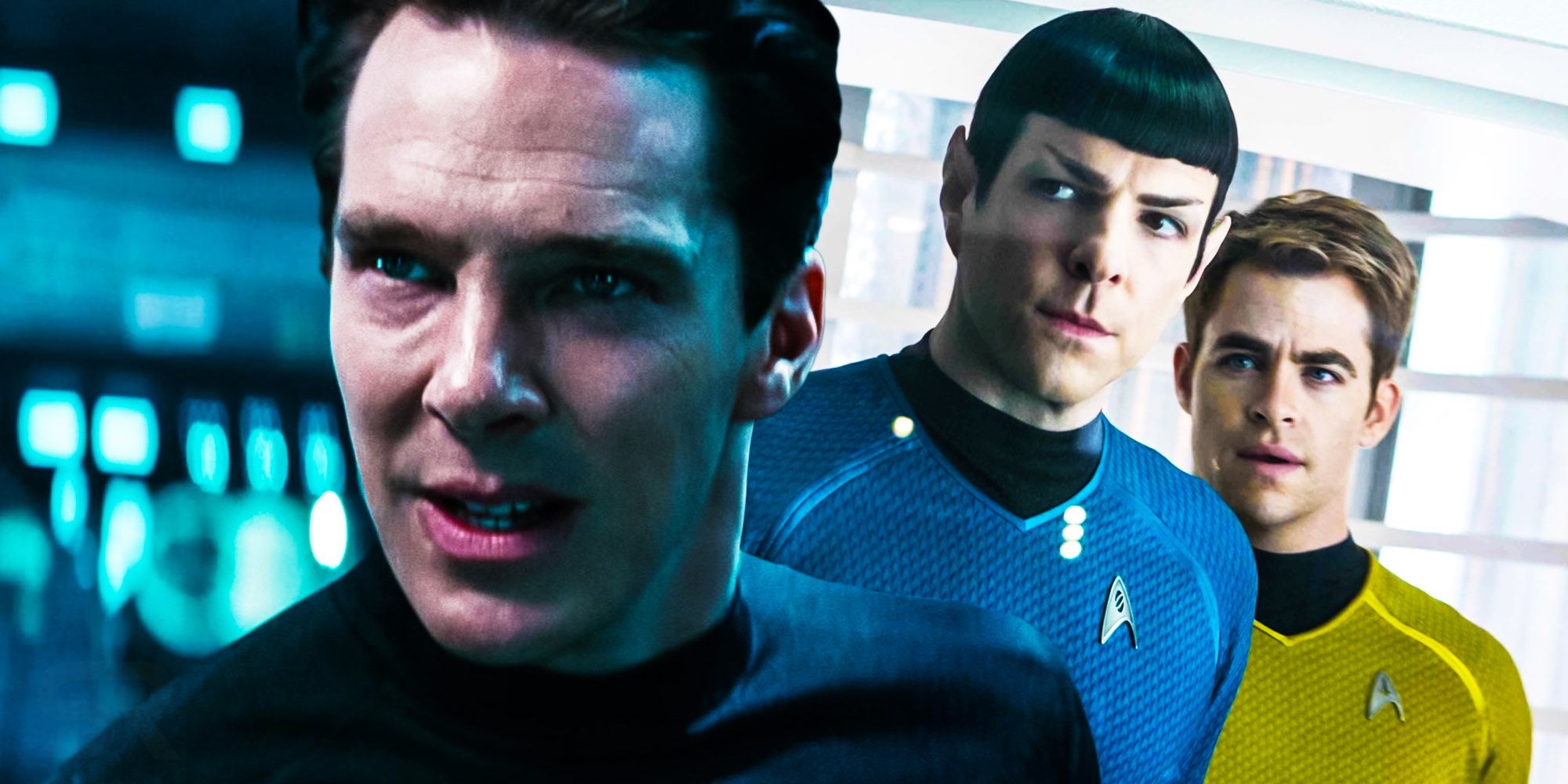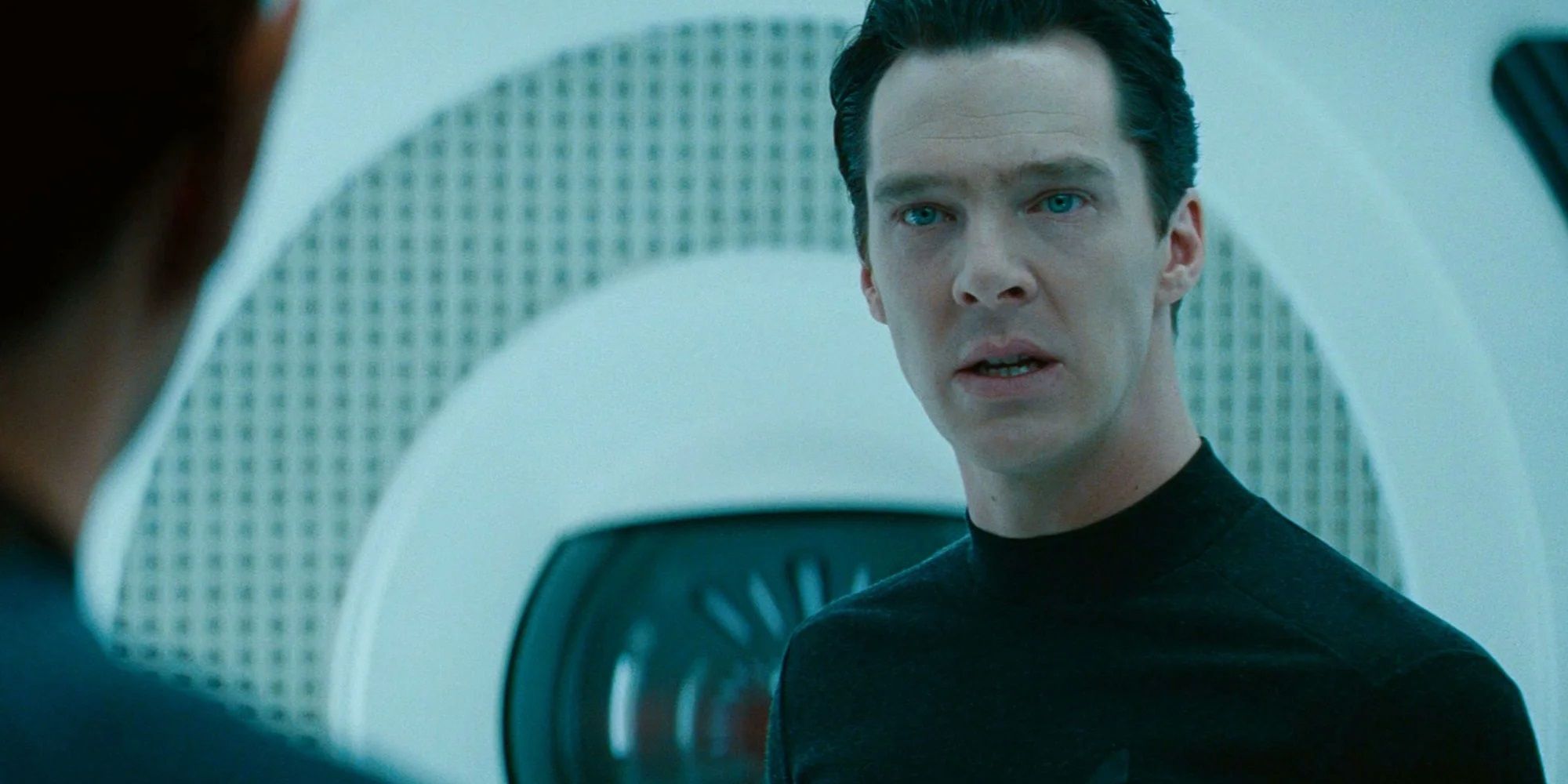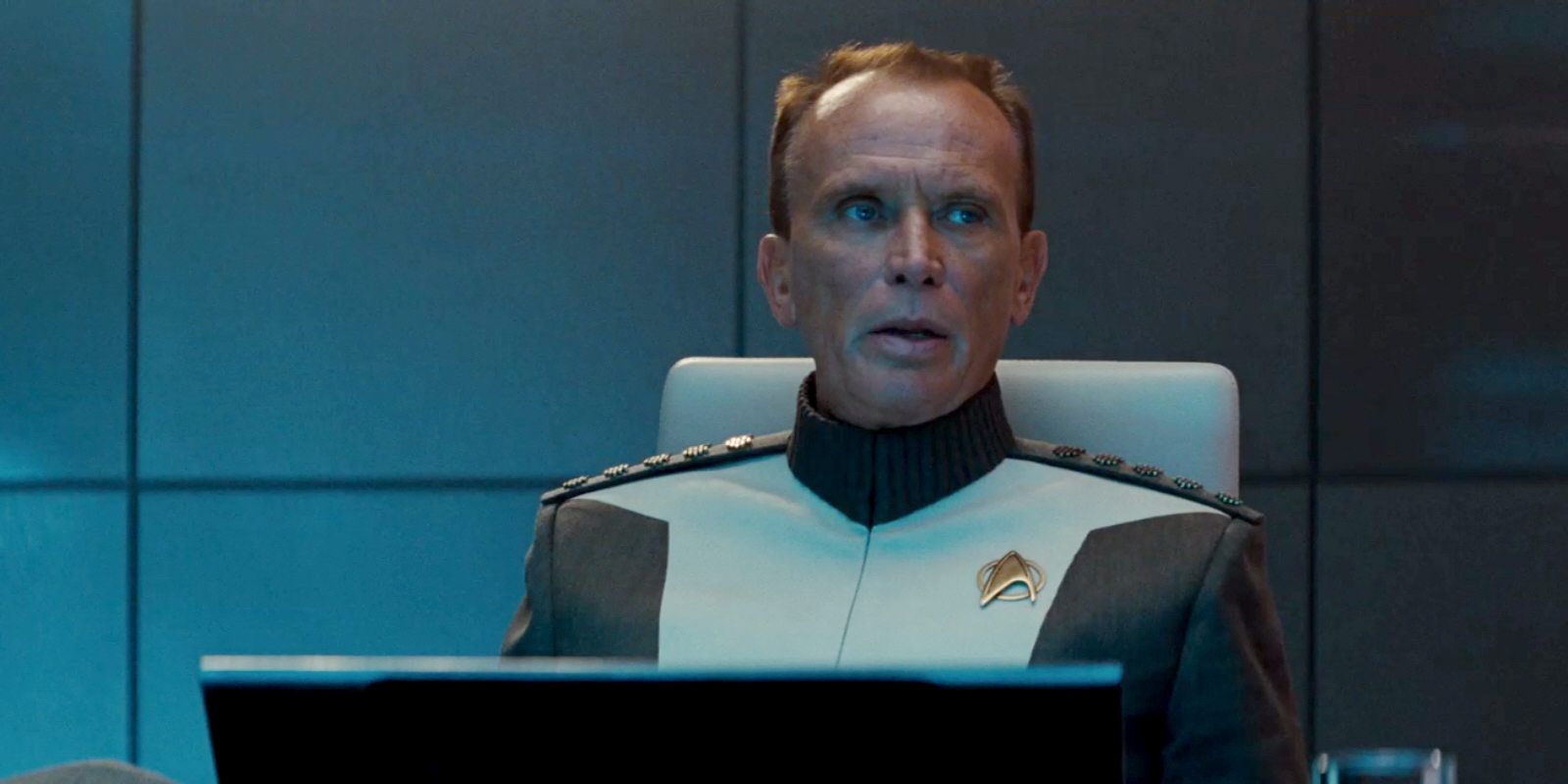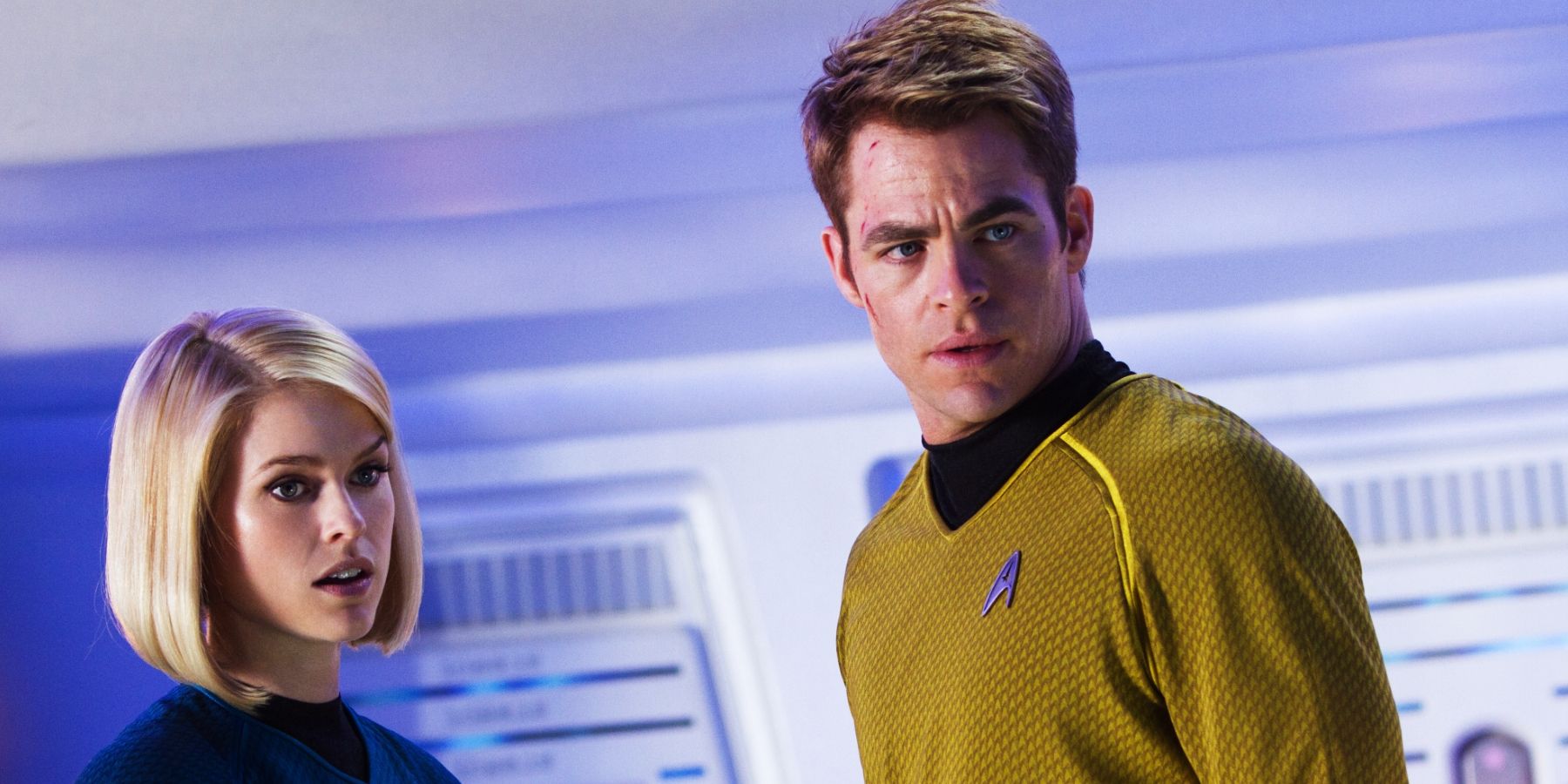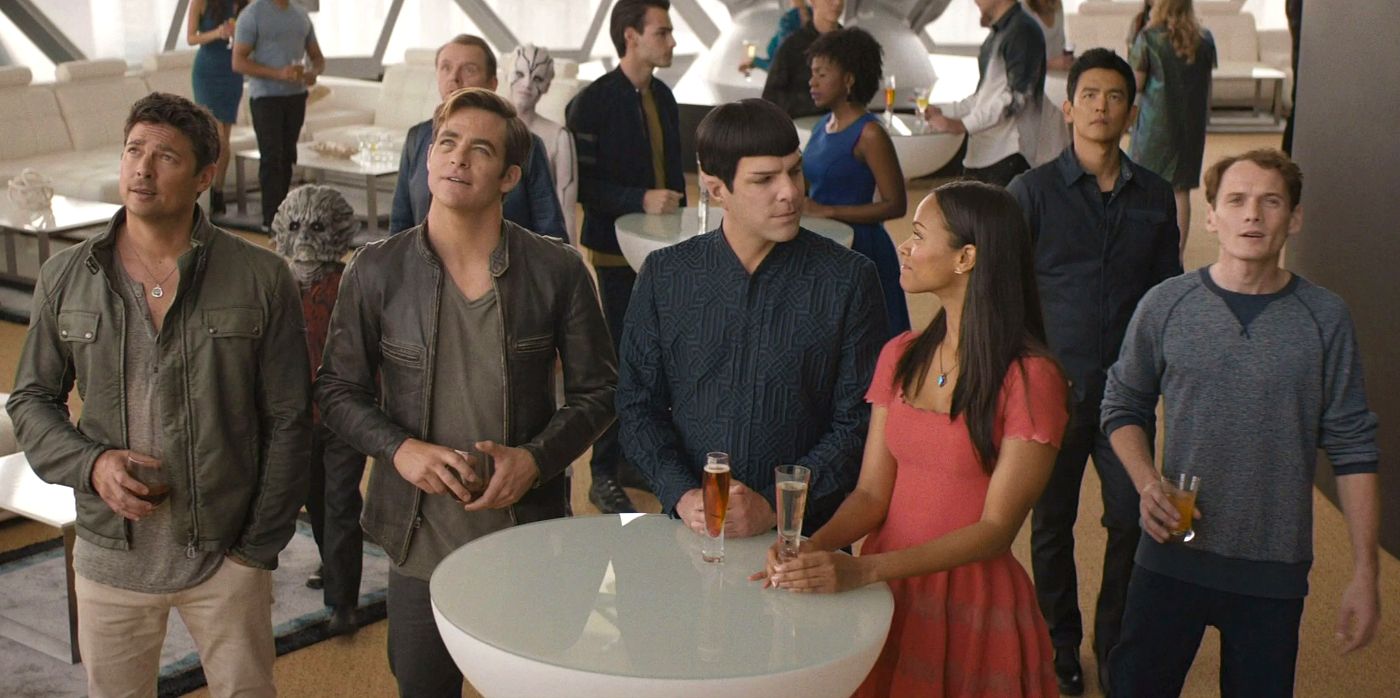The ending of Star Trek Into Darkness was an action-packed but bewildering spectacle that played like a funhouse mirror version of Star Trek II: The Wrath of Khan where the roles of Captain Kirk (Chris Pine) and Spock (Zachary Quinto) were strangely reversed. After Khan (Benedict Cumberbatch) killed Admiral Alexander Marcus (Peter Weller), he took over the USS Vengeance and threatened to destroy the USS Enterprise if Spock didn't give him the 72 photon torpedoes containing his genetically-engineered followers. Spock tricked Khan by sending over the torpedoes without the cryogenically frozen people inside, and he detonated the weapons to cripple the Vengeance.
Once Kirk, Scotty (Simon Pegg), and Dr. Carol Marcus (Alice Eve) beamed back to the Enterprise, the starship lost power and began to crash-land into the Earth. Kirk entered the warp core and aligned it, and he received a fatal doze of radiation. As Spock witnessed Kirk's death, Khan crashed the USS Vengeance into San Francisco and tried to escape. Spock beamed down to kill Khan but during their chase, Dr. Leonard "Bones" McCoy (Karl Urban) realized Khan's 'super blood' could revive Kirk, whom he placed in a cryo tube. Uhura (Zoe Saldana) beamed down to help Spock capture Khan, and McCoy was able to synthesize a serum from Khan's blood to save Kirk's life. A year later, the USS Enterprise was re-launched on a five-year mission with Captain Kirk in command. At the end of Star Trek Into Darkness, Kirk learned that vengeance is not what Starfleet is about and his experience against Khan, who was placed back in cryo freeze, matured him as Captain of the Enterprise.
Khan's Star Trek Into Darkness Villain Plan Explained
Khan was the primary villain of Star Trek Into Darkness, although he was rebelling against being a victim of the corrupt Admiral Marcus for most of the film. Khan's primary goal was to kill Marcus, destroy Starfleet, and reunite with his 72 followers, but the film's plot made his methods confusing. In the first act of Star Trek Into Darkness, Khan, in his fictional identity of Commander John Harrison, engineered the bombing of the Kelvin Historical Archive in London. But the archive was a front for Section 31, Starfleet's black ops agency, which was using Khan to develop weapons for Starfleet under Marcus' orders.
Khan bombed Section 31 because he knew Starfleet protocol dictates Marcus and the senior staff would convene at the Daystrom conference room at Starfleet Headquarters. Aboard a stolen jumpship, Khan attacked the Starfleet brass, but he failed to kill Marcus. Instead, Kirk's mentor, Captain Christopher Pike (Bruce Greenwood) died in the attack. Khan then used Scotty's transwarp technology to beam himself to Kronos, the Klingon homeworld. Kirk volunteered to take the Enterprise to Klingon space and kill Khan, but when his crew argued against the immorality of this mission, Kirk changed his mind and set out to apprehend Khan to make him face trial. Khan, in turn, saved Kirk's away team from the Klingons, and he surrendered to Kirk, having surmised that the Captain didn't know he was set up by Admiral Marcus and that Section 31 sabotaged the Enterprise's warp core. Playing prisoner was the fastest way Khan could get to Marcus.
Khan knew Marcus would personally come when he learned Kirk disobeyed orders. When Marcus arrived aboard the USS Vengeance to destroy the Enterprise, Khan agreed to work with Kirk to infiltrate Marcus' starship. But Kirk betrayed Khan first and had Scotty stun him. When Khan quickly awoke, he attacked and killed Marcus. At that point, Khan's goal was to get his followers back from the Enterprise and use the Vengeance to destroy Starfleet. But after Spock tricked him and damaged the Vengeance, Khan settled for crashing Marcus' starship into Starfleet Headquarters before escaping. Had Khan succeeded, he and his followers would have used the Vengeance to take out Starfleet systematically, but instead, the genetically-engineered tyrant was placed back in suspended animation.
Admiral Marcus' Star Trek Into Darkness Villain Plan Explained
Admiral Alexander Marcus was Star Trek Into Darkness' other villain and, in a way, he was worse than Khan. Marcus' backstory is that after Nero (Eric Bana) destroyed Vulcan in Star Trek 2009, the Admiral feared that Starfleet wasn't prepared for a future war with the Klingons. Marcus used Section 31 to search for ways to 'militarize' Starfleet, and they discovered the ship containing Khan and his followers in space. When Marcus realized Khan was the genetically-engineered warlord from 300 years in the past, he revived Khan and forced him to develop weapons and tactics to fulfill his vision of a militarized Starfleet. As an incentive, Marcus kept Khan's followers prisoner and threatened to kill them if he didn't cooperate.
As "Commander John Harrison," Khan helped develop the USS Vengeance and the special photon torpedoes that ended up housing Khan's followers in suspended animation. But when Khan decided to take revenge on Marcus, destroyed the Section 31 facility and operatives in the Kelvin Archive, and attacked Starfleet Headquarters, Marcus saw Kirk's desire for vengeance as an opportunity to rid himself of Khan. However, Marcus never intended for Kirk and the Enterprise to return from the mission to Kronos, and the Admiral wanted to start a war with the Klingons - but on Starfleet's terms. Marcus had Section 31 sabotage the Enterprise's warp core so that the ship would be stranded in Klingon space after Kirk fulfilled his original mission to launch 72 photon torpedoes at Kronos from the edge of the Neutral Zone.
When Marcus learned Kirk disobeyed orders and captured Khan instead, he personally led the Vengeance to destroy Kirk, Khan, and the Enterprise. The Admiral never had any intention of letting Kirk survive, and the fact that his daughter, Carol Marcus, pleaded with him didn't dissuade the Admiral. If Marcus had his way, he would have annihilated the Enterprise and everyone aboard, including Khan and his followers, fixing the "mistake" Marcus made by waking them from cryo sleep. Marcus would then have the war with the Klingons he wanted, and the Admiral believed Starfleet would defeat their enemies thanks to the Vengeance and Section 31's technology.
What Went Wrong With Star Trek Into Darkness
Star Trek Into Darkness features terrific performances from the cast and thrilling action set pieces. The film's failings stem from its numerous creative missteps and a fatal blunder in how the Star Trek sequel was marketed. J.J. Abrams and his writers, Damon Lindelof, Alex Kurtzman, and Roberto Orci, decided that in spite of having a clean slate to do whatever they wanted in the alternate Kelvin Timeline, they would make Khan Noonien Singh the main villain of the movie. Khan's inclusion then necessitated rehashing multiple aspects of Star Trek II: The Wrath of Khan. But the novelty of this was lost on most Star Trek fans, who saw using Khan in the sequel as a creatively bankrupt decision. It also didn't help that Khan, a person of color originally played by the iconic Ricardo Montalbán, was whitewashed by the casting of Benedict Cumberbatch.
In Star Trek Into Darkness' defense, killing Kirk and pitting Spock against Khan had the benefit of the Vulcan being a physical match for the genetically-engineered superman in a way Kirk simply isn't. But by the end of the film, the bereft Spock as a violent madman raining punches on Khan was a bridge too far from the cool, logical Vulcan Spock is meant to be. Many other baffling creative choices like Kirk being so immature that he unapologetically broke the Prime Directive, and so bloodthirsty for vengeance that he committed the Enterprise to an immoral manhunt, the controversy sparked by an unnecessary scene where Carol Marcus stripped to her underwear in front of Kirk for no reason, Leonard Nimoy's Spock telling Zachary Quinto's Spock how to beat Khan, and Kirk's death being instantly reversed thanks to Khan's "magic blood" sank Star Trek Into Darkness in the eyes of audiences in spite of the film's strong points.
It's possible Star Trek Into Darkness might have been better received if the film's marketing was upfront that Benedict Cumberbatch was playing Khan. But J.J. Abrams was at the peak of his "mystery box" style of movie marketing in 2013, and the filmmakers deliberately misled (or outright lied to) the audience to preserve their 'surprise' that John Harrison was really Khan. Unfortunately (and predictably), the reveal overall was not met with the excitement Abrams and Bad Robot hoped for. Trekkers saw Star Trek Into Darkness as foolhardy and uninspired for remaking the beloved Star Trek II yet again, just 11 years after Star Trek: Nemesis also did its own failed version of The Wrath of Khan. Sadly, Star Trek Into Darkness' reputation hasn't been buoyed in the decade since its release, and the film ultimately squandered the goodwill created by the success of Star Trek 2009.
How Into Darkness Hurt Star Trek Beyond
In spite of its less-than-stellar reception from fans, Star Trek Into Darkness raked in $467-million at the box office, over $80-million more than the more enthusiastically-received Star Trek 2009, and it's actually the highest-grossing Star Trek film. However, Star Trek Into Darkness ultimately cooled audience interest in the Chris Pine-led Star Trek movie franchise. In spite of a switch in directors from J.J. Abrams to Justin Lin, and a superior script by Simon Pegg and Doug Jung that successfully evoked the tone of Star Trek: The Original Series, Star Trek Beyond underperformed in the summer of 2016, earning $343-million as the lowest-grossing film of the Kelvin trilogy.
Star Trek Into Darkness soured the optimism for the boundless potential of the Kevlin timeline and, instead, Abrams' trilogy earned a reputation for regurgitating what worked in past Star Trek movies and TV shows. In turn, the excitement from general audiences was lacking for Star Trek Beyond when it hit theaters, and its July 2016 release date was also mistimed in a crowded summer movie marketplace when it could have been positioned to celebrate the 50th anniversary of Star Trek in September 2016. Sadly, Star Trek Into Darkness marked the downturn of J.J. Abrams' Star Trek movies, and the franchise still hasn't recovered, as evidenced by Paramount's inability to get Star Trek 4 off the ground.

